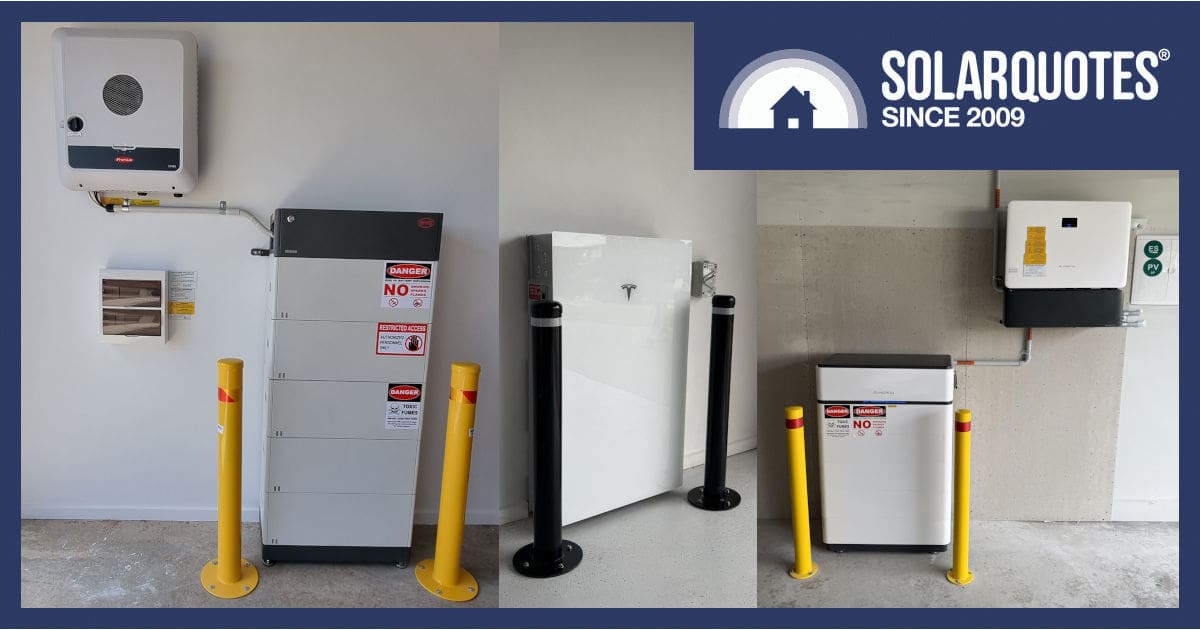
If you have a home battery installed in a garage, carport or driveway, chances are it will be behind a bollard. While Australian regulatory standards call for “protection”, here’s some better ways to abide by the rules.
How Do You Protect A Battery?
Although bollards are a popular option, they usually aren’t installed in a way that offers meaningful protection. Better options include installing the battery in an elevated position, or using alternative solutions such as wheel stops. Installing a battery outside the garage is another alternative, but in this case a kiosk is advisable to protect it from weather.
The Evidence Is Everywhere
A good carpenter I know sometimes comes out with an unforgettable pearl of wisdom1 and it’s one which always comes to mind when I see a home battery installed in a garage is this:
You can paint that as yellow as you like,
they’re still gunna hit it.
He’d dead right of course. You see the evidence everywhere: supermarkets, train stations, in front of the convenience shop door. These silent sentinels often stand crooked, with scratches in the paint and scars where the candy stripe tape has failed to catch enough attention.
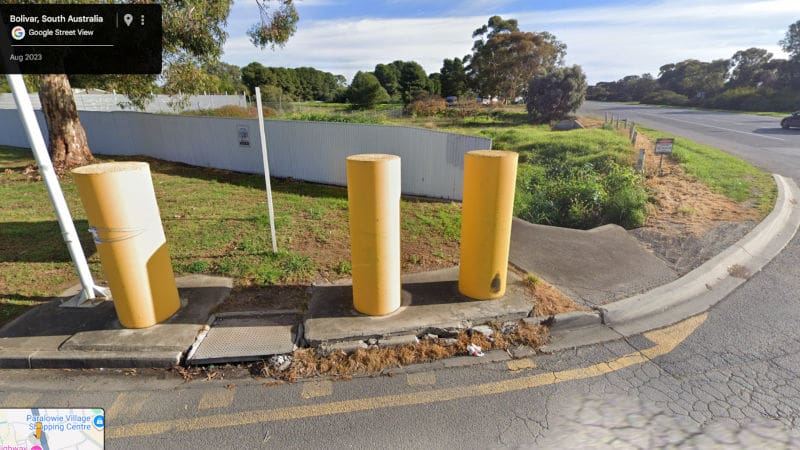
Just look at these magnificent bastards… replete with black tyre marks.
I think my favourites are a set supposed to stop road trains going down the drain.
A highway petrol station I once frequented kept installing ever-stronger bollards, as they kept failing to do their job. Over the years these obstacles grew bigger and were buried deeper, until finally, steel-cased, concrete-filled, half a metre in diameter and 1.5metres tall, they could withstand the errant truck attacks that uprooted their predecessors.
Bollards will protect things if they’re built right, but the bulls#!t bought at hammerbarn are bollocks for batteries.
When parking the car, a bolt down post isn’t going to help if you stab the wrong pedal or select the wrong gear, and they’re not mentioned in Australian Standard 5139 in any case.

I’ve heard some shocking abuse directed at a solar inverter and battery that refuses to connect to WiFi – they seem immune to verbal attacks though.
Cheap Bollards Can Be Worse Than Nothing
Under Australian Design Rules (ADRs), your car must avoid damaging squishy persons. Mirrors fold up, bumpers are filled with styrofoam, even bull bars – designed to fend off the wildlife – aren’t allowed to have sharp edges to puncture pedestrians.
The ADRs go to great lengths mandating that cars deform, absorb energy and soften impacts when they hit something.
A bollard concentrates the broad impact of a car into a single point. It might not be sharp, but like a jousting stick it’s certainly more likely to puncture a battery cell.
Light Duty Protection
Unless you have a 100mm-plus hole cored through the concrete floor to accept a heavy wall steel pipe, you’re not taking the matter seriously.
Whether they use masonry bolts or screws into plastic plugs, bolt-down bollards aren’t heavy duty. In fact I’ve seen many fixed to pavers, they’re just adorable.
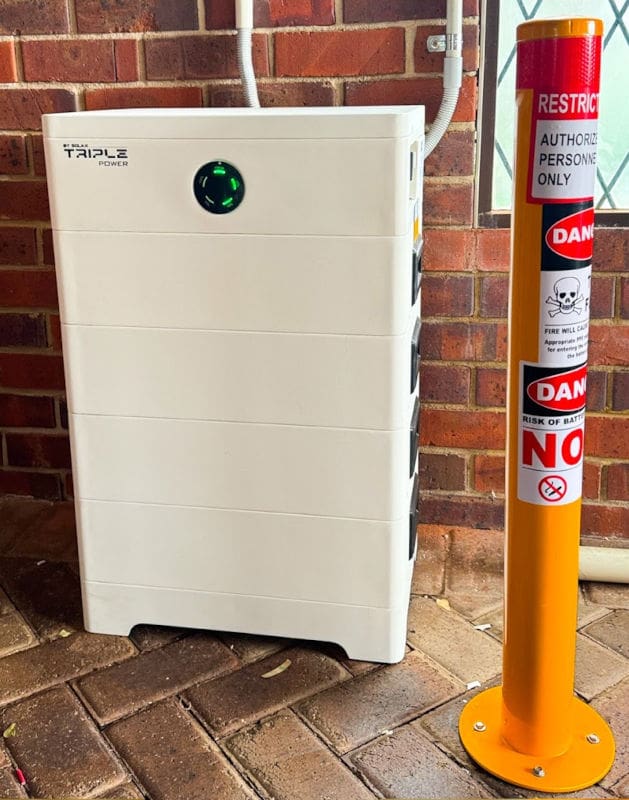
Given that nice big lever, I reckon I could reef those pavers out with my bare hands. The warning labels are a pragmatic approach though as they shouldn’t be stuck on the equipment.
A lightweight bollard may prevent you smashing the glass fascia on your Tesla Powerwall 3 when you fling 50kg of car door at it, but it’s not going to help when faced with 2 tonnes of car, unless perhaps it’s at a literal snails pace, but there are better fixes for a slow-rolling vehicle.
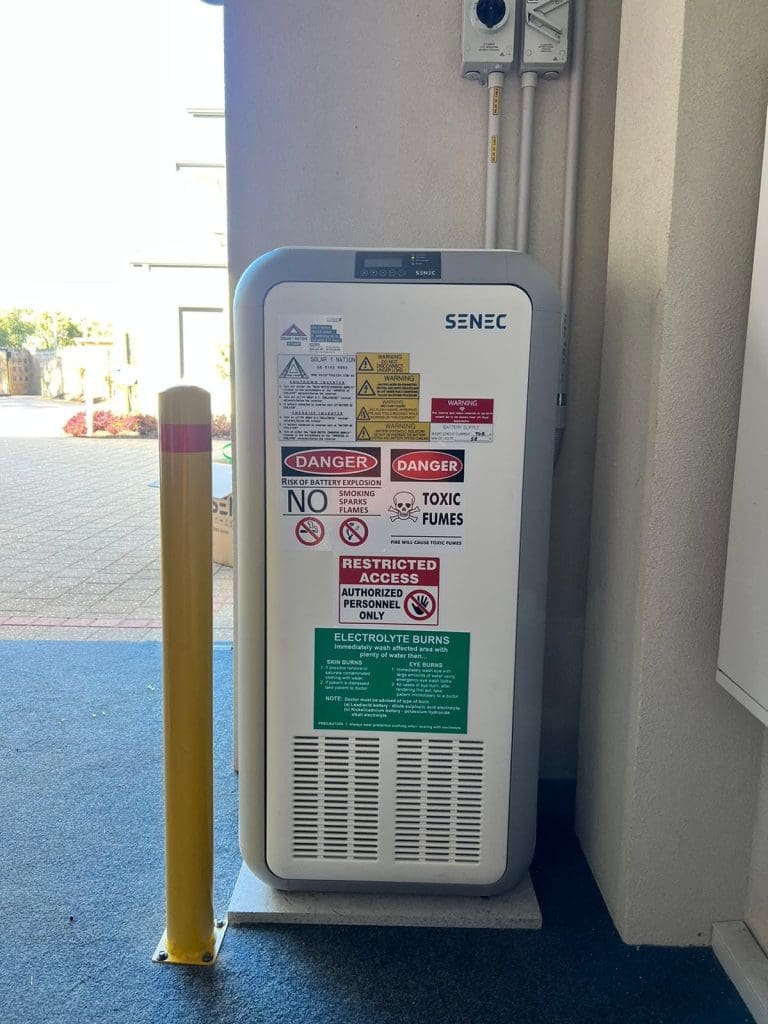
Like the four screws holding the yellow post up, those stickers aren’t protecting anything. They shouldn’t be on the equipment and the green one belongs on a lead acid battery.
The Best Solution Requires Heavy Lifting
Getting batteries up and out of the way is probably the best option, but being grotesquely heavy means they’re sometimes difficult to mount and probably an OH&S liability for installers.
I know some are taking a small trolley-style crane with them to make this process easier.
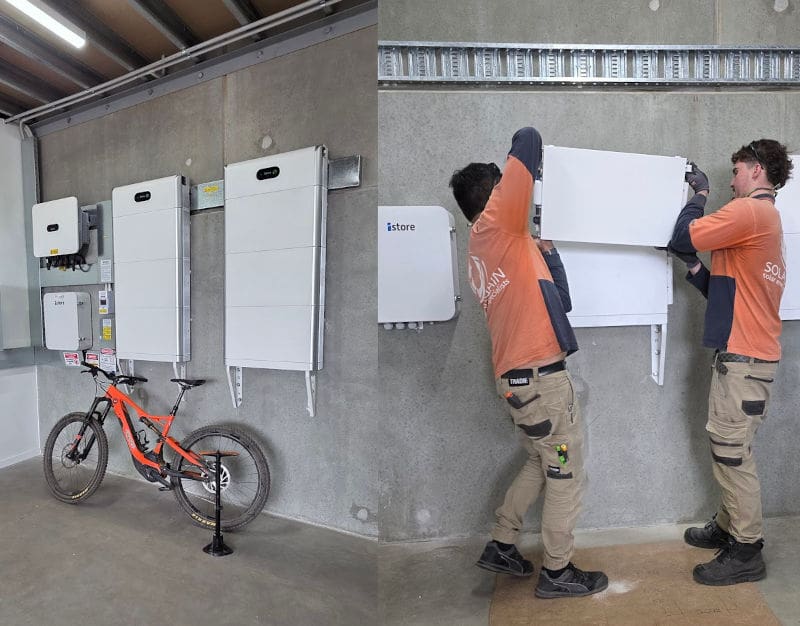
A no-bollocks solution from iStore and Solargain Adelaide.
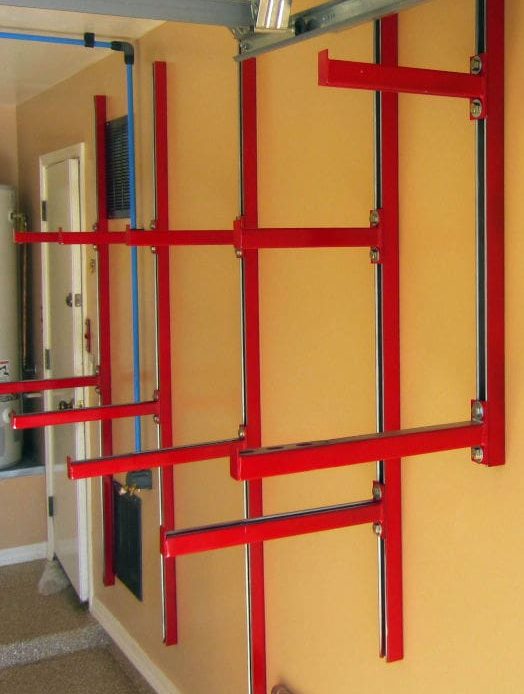
You can make almost anything with unistrut
Alternatives like unistrut support hundreds of kilos with brackets designed for air conditioning units. A cross bar and two floor struts would make this wood rack above into an inexpensive battery cage.
For a real grand design, we can’t go past this bespoke cage delivered by Eddy and the team from NRG Adelaide. By strutting this frame to the wall it becomes a really solid solution.
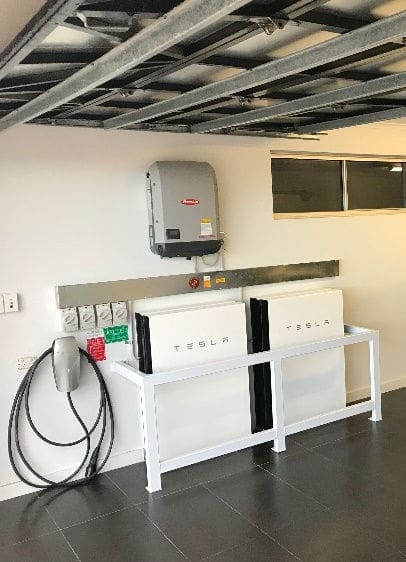
You could do this with some pallet racking, unistrut or Downee clamps for a more universal approach I’m sure.
Wheel Stops Are An Alternative
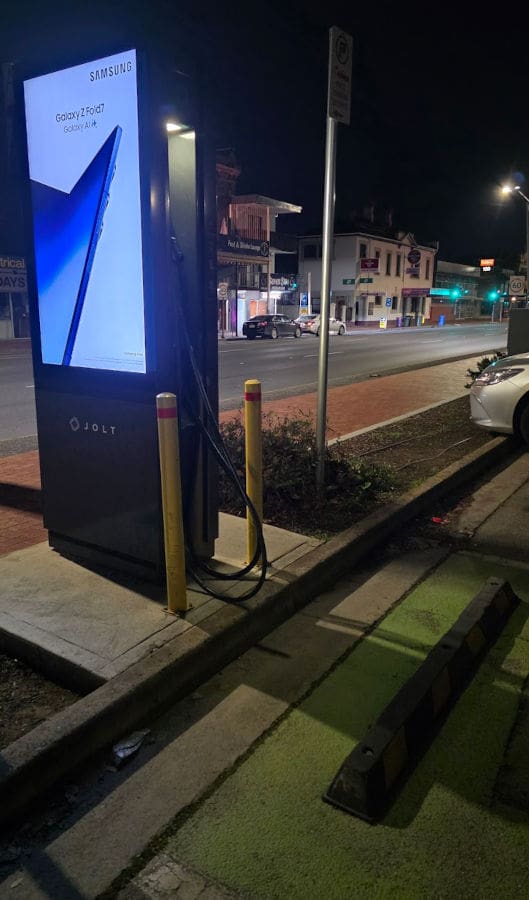
I love Jolt and their first 7kWh for free deal, it’s half a tank full in a modest EV.
I chuckled at this EV charging station protection setup pictured above recently, but it raises a few good points.
Really expensive hardware in a public setting usually has bulletproof, industrial-grade protection, however the hierarchy here is a rubber wheel stop, concrete kerb and some decorative bollards, perhaps to trigger your parking sensors?
The one disappointing part is the question of how you’d access this in a wheelchair.
Solar installers have taken the same approach, like this beautiful example of a wheel stop from Skyline Solar below. Perhaps the only drawback being a potential trip hazard.
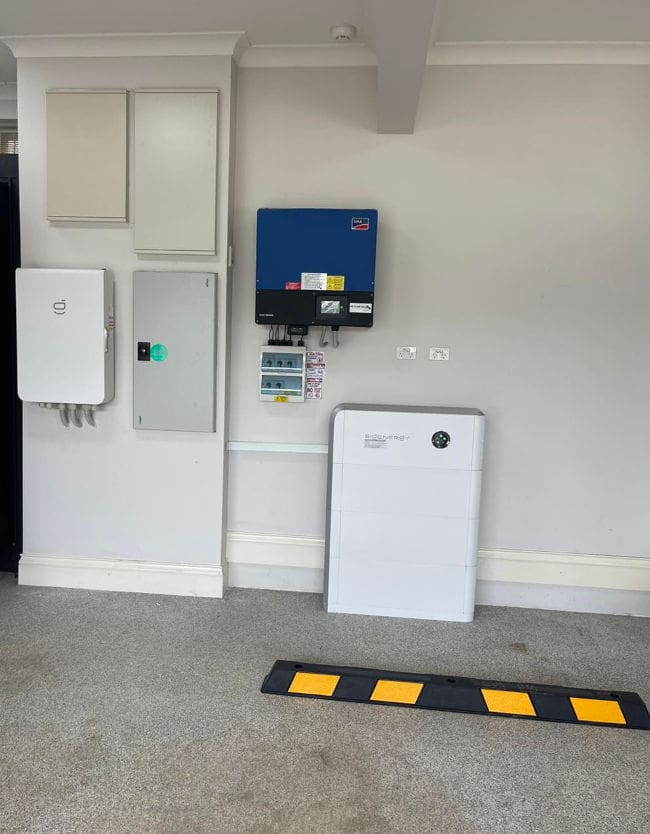
An automatic car, idling in gear, won’t climb a wheel stop like this.
The other off-the-shelf solution available is a cage. These were commonly used for inverters but changes to standards mean they’re only used for theft prevention now.
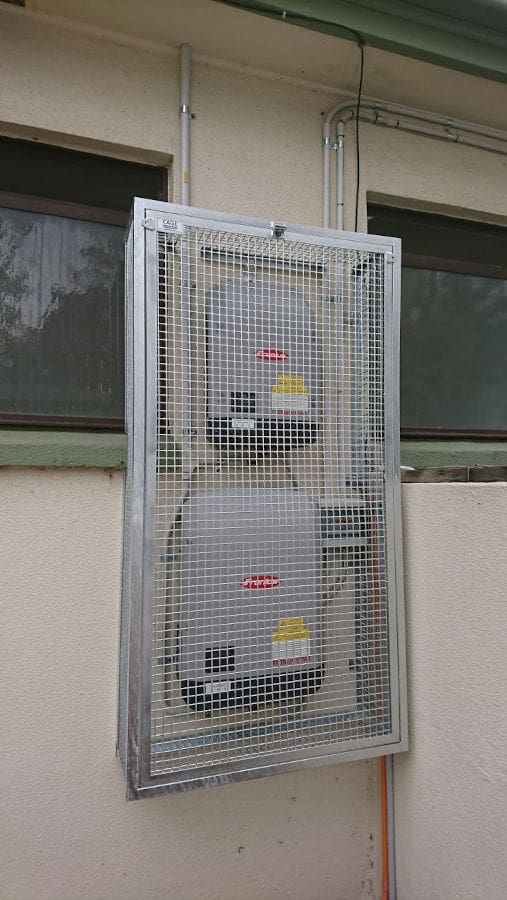
Rules used to dictate cages for inverters over 600VDC.
Going Gardening
I still think a garage is a good place to keep a battery for 10 years, just like it is for your car, which also houses a battery.
But if you’d prefer to keep the perceived (but very low) fire risk away from your house, a dedicated kiosk outside might be the answer.
If you have the space and budget, it might save damage wrought by garden tools and great piles of garage goods.
We used to build gas tight ventilated enclosures for lead acid batteries used in remote area power. Putting an angled top on the box kept the space clean, so they could be accessed if need be.
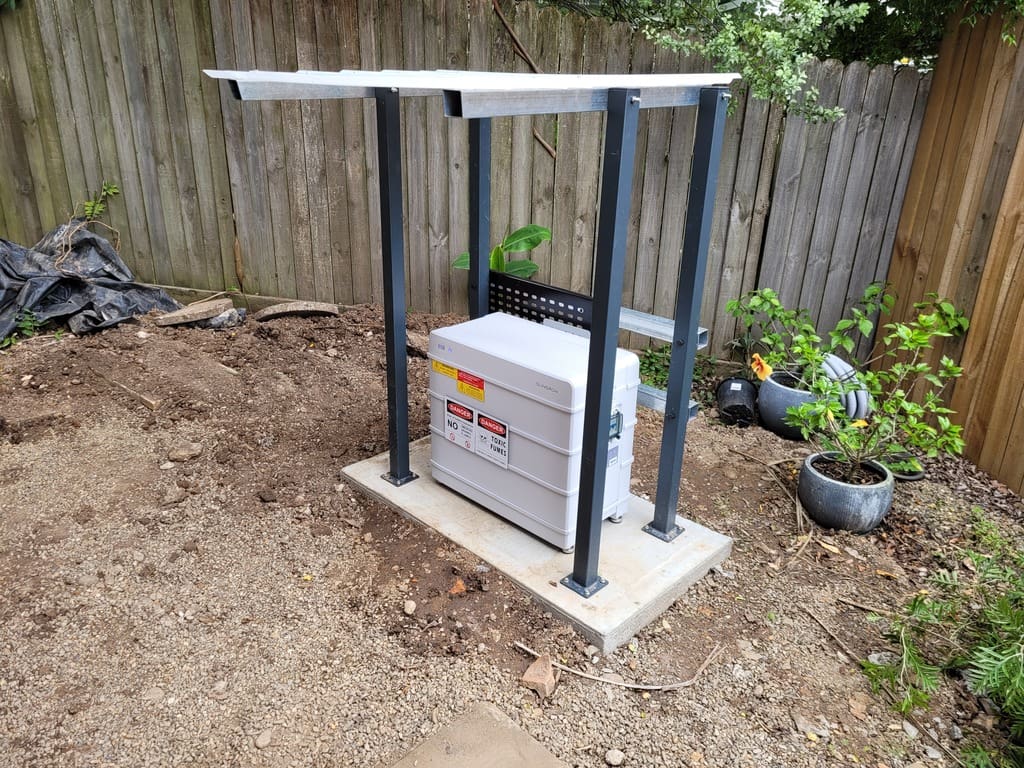
Building a kiosk in the garden isn’t a silly idea but I’d still put a 2mm thick steel skirt around this to meet WSX2 level mechanical protection. Something that will withstand a brush cutter with a solid blade.
While lots of equipment has a degree of weatherproofing, keeping things out of the weather really is still essential. This LG example below was used to replace a sadly defunct Redflow battery, which had it’s own little shed built around it.
The first LGChem failed under warranty but hopefully the backboard and angled rain shed will help the new unit.
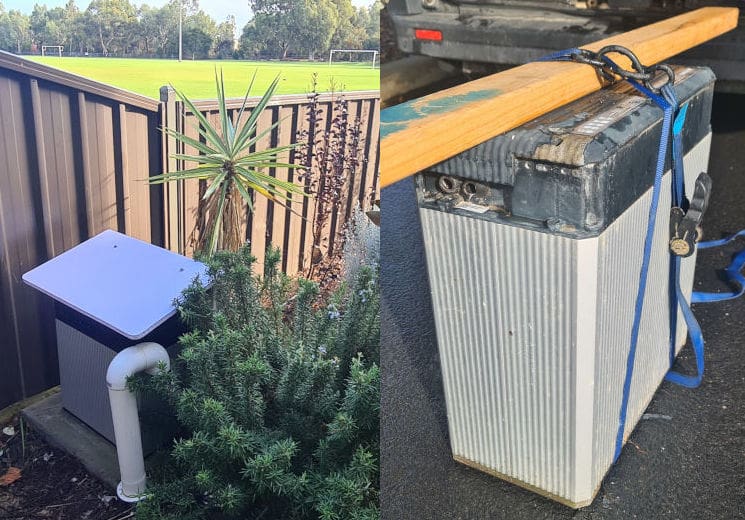
The battery on the right was only a couple of years old, but once moisture got under the powdercoat finish, corrosion really got going.
The Right Answer Depends On Your Home
We’ve written previously about where you’re allowed to put batteries under restrictive Australian rules. Just bear in mind that what you need for your place may be unique, so a site visit before installation day can save a lot of heartache.
Footnotes
- Wisdom is something I doubt you’ll ever see from the lesser trades like plumbing or plastering ↩

 RSS - Posts
RSS - Posts



Bollocks indeed
When my installer put my 15 kWh Huawei battery in our garage three years ago they didn’t even bother putting a bollard in. They just installed battery on the garage wall and left it sitting there on the floor of the garage with no protection at all. When I asked them about bollards they said that if we wanted one we should just go to Bunnings, buy one and put it in ourselves. It hasn’t had a bollard or any protection for the last three years. Do you think it’s worthwhile now for me to go and buy a bollard, drill and bolt it into the slab infront of the battery?
Rohan: – “Do you think it’s worthwhile now for me to go and buy a bollard, drill and bolt it into the slab infront of the battery?”
If you are just dynabolting the flanges of surface-mounted bollards to a concrete slab, then I’d suggest you would be wasting your time & money. They would not provide any useful resistance against impacts from the momentum of multi-tonne vehicles and would only be there just for show.
Thanks Geoff. I was thinking of doing it to provide safety and for legal reasons but in that case and after reading Anthony’s article I don’t think I’ll bother. Cheers.
Hi Geoff,
I recently saw a classified add for redundant industrial gas bottles. At a guess they’re 200mm diameter and 1500mm tall.
Cemented into the slab you’d have a tough time moving one with any light car, it would be more durable than a brick veneer wall.
However, the installation would be expensive, I could imagine $500 just to get the hole cored or a piece of slab cut and lifted.
Anthony Bennett: – “I recently saw a classified add for redundant industrial gas bottles. At a guess they’re 200mm diameter and 1500mm tall.”
I’d suggest 200 mm diameter would perhaps be overkill.
Here’s a bollard detail that may be of interest. A 6-inch diameter pipe bollard for resisting a 4,500-pound (2,041 kg) vehicle impacting at 5 miles/hr (8 km/hr).
https://www.jlconline.com/how-to/foundations/building-a-bollard_o
Equivalent material AS/NZS 1074:1991 150 SHS Heavy pipe (165.1 mm OD x 5.4 mm wall)
https://www.southernsteel.com.au/structural-tube-pipe/
Need to update some previous articles if bollards are no longer acceptable best practice in the view of SQ. There is also a bunch of other resources suggesting bollards in general as good/best practice.
https://www.solarquotes.com.au/battery-storage/installation/
– recommends bollards as best practice
https://www.solarquotes.com.au/101-guides/buying-batteries/
says – you’ll need bollards or other
https://www.solarquotes.com.au/blog/battery-installations-insights/
– May require bollards
Erac also directly suggest bollards.
https://www.erac.gov.au/wpcontent/uploads/2021/03/Battery_Energy_Storage_System_02Feb2021.pdf
And Some manufacturers.
https://enphase.com/en-au/download/enphase-energy-system-installation-compliance-guide
QLD Gov
https://www.qld.gov.au/housing/buying-owning-home/energy-water-home/solar/battery-buyers-guide/tips-for-buying-a-home-battery#:~:text=Your%20battery's%20location%20and%20position,storage%20equipment%20electrical%20safety%20requirements.
Hi Jake,
Thanks for the thorough research, we’ll get to some editing soon I’m sure.
The ERAC link is broken for me.
As for Queensland, knowing what they’ve done with GSD devices and charging people coal fired prices for their own solar power, I take their advice with a grain of salt.
Cheers
https://www.erac.gov.au/installations/installations-resources/
The second PDF “Battery energy storage systems” consistent approach to interpreting the rules.
Suggests Bollards.
If bollards truly aren’t suitable then why aren’t people being defected for it.
Hi Jake,
Thanks for the link. Here’s the passage…
1. External Damage
A BESS must not be installed,
a. In a location where damage from external influences may be expected e.g. from
damage by a vehicle.
i. Additional measures may be used to mitigate the risk, e.g. a bollard/s installed in
such a manner that prevents a vehicle from making contact with the BESS, or
ii. The installation in a position or location that provides the protection necessary
prevent a vehicle from making contact with the BESS.
I think the operative words here “prevents a vehicle making contact”
Installing a bollard ticks the box for mechanical protection, in a lot of instances it’ll be better than nothing, especially if they’re positioned *not* to strike the battery if a car hits them, but in my humble opinion, it’s a bit half arsed to rely on four screws.
When owner-building a bit over 35 years ago, the council required a collision barrier in front of the brick column supporting the centre of the 7m x 6m lounge over the double garage. The column was between the parking bays, and the garage doors only 2.4m wide, so you’d pretty nearly jam in the brick doorway trying to line up on it, but no barrier, no permit.
I bought two 1.5 metre lengths of 6mm wall thickness 100 x 100 mm RHS, and set them half a metre deep in a deeper pocket in the slab. (Yes, anything merely bolted on top is an utter joke.)
In any retrofit, even after lifting the battery above the impact zone, it’s good that solar batteries are mostly LFP, as they could still be knocked off the wall, and negligible flammability is then gold. But arcing & petrol? An LFP-equipped BEV seems safer. (E.g. base model MG4)
A non-habitable room, free of bulk combustibles, and LFP batteries, suit me. A house fire would eventually generate toxic battery smoke – a good time to evacuate.
Agreed. I am always amused when I see a bollard bolted to a floor in a garage.
For those who like Bollard porn, can I suggest World Bollard Association on your favourite social media platform
I have had my Powerwall 2 for three years now. It runs as advertised, with no issues at all. I love being able to charge during off peak times ( if needed during winter). I am on track to record my second year of sub $200 in bills for the whole year. I installed a bollard that I was able to get for free from work, so its construction is very solid. Not just a single pole, but a wide, double braced one.
What’s wrong with a table tennis ball hanging from the ceiling?
Can someone clarify, whether this extra protection is necessary for batteries standing on the floor in the corner of a two cars wide garage right next to the garage door? A car could hit it only if the driver attempted to drift into the garage attempting to park sideways. Practically never going to happen. But hypothetically not impossible. It would be a multi Darwin award worthy performance.
Cheers,
Tomi
My battery installation included bollards (I got the white/grey ones instead of the ugly yellow/red), however I also bought (from Bunnings) those hard rubber wheel stops (like in the image in the article) and installed it at the right distance before the bollards. That way the cars stop before hitting the bollards (which also ends up being ideal (distance wise) for charging our EV’s)
Finding a suitable location around the house for a battery installation can be somewhat difficult for many people wanting to have a bank or two installed.
Thankfully, my IP66 Inverter & battery bank was installed to specifications on the south side of my home, secured to the wall, under eaves and of course in shade. No bollard required.
A much better location for us than in our garage.
I plan to put my batteries outside, near my inverter, on an east-facing wall, shaded by a fence on top of a retaining wall (total 3 m), under the eave of the (single story) house – should I expect this to be sufficiently safe and weather-enduring?
No need for bollards, as the only vehicle near will be a wheelbarrow!
As a slight aside, several years ago I supervised some consumer crash tests of an EV. It included a side pole test which is equivalent to sliding sideways at 30km/h into a telegraph pole. In addition to looking for head injury risk for the driver (inflatable curtain performance) we looked at battery and circuit integrity. So far as I know no consumer tests have found a problem with EV batteries in these types of crash tests.
BTW – Australia has not implemented a global standard for pedestrian protection in the Australian Design Rules. Any protection offered by vehicles sold in Australia is due to ratings by Australasian New Car Assessment Program or due to regulations in Europe and Japan influencing vehicles imported into Australia.